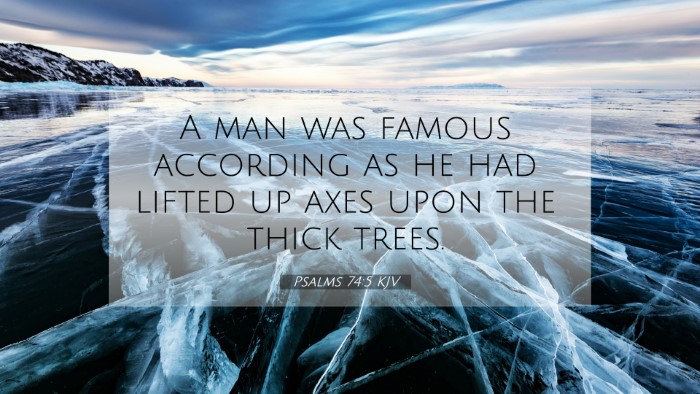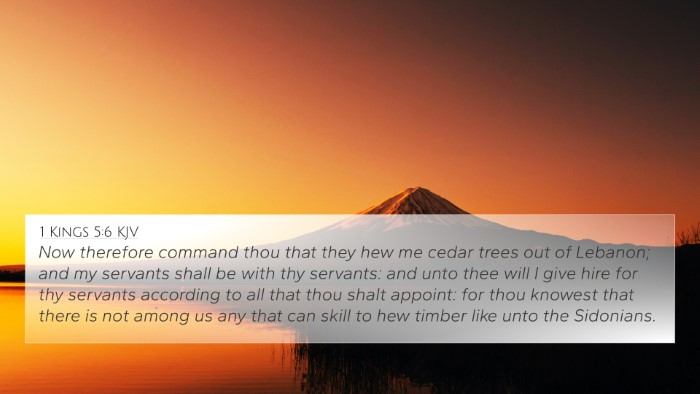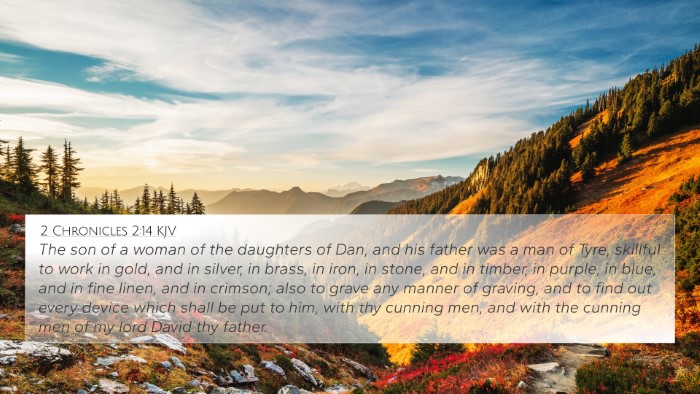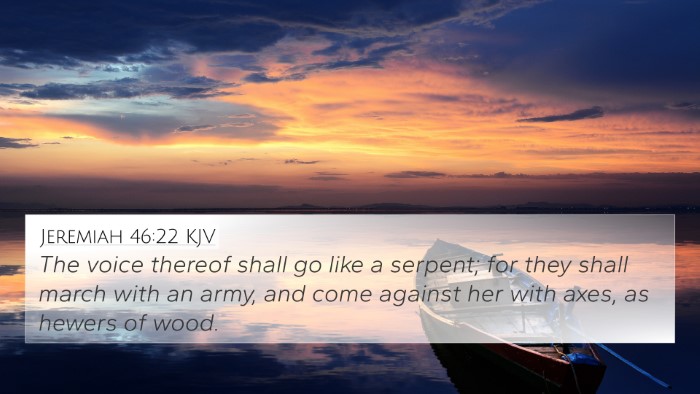Understanding Psalms 74:5
Psalms 74:5 states: "A man was famous according as he had lifted up axes upon the thick trees." This verse presents a vivid imagery which is understood in the context of the Psalmist lamenting the devastation of Zion and God's sanctuary. Combining insights from notable public domain commentaries, we can derive a deeper understanding of this passage.
Contextual Background
The Psalm is attributed to Asaph and reflects a time of crisis for the people of Israel, possibly during the Babylonian conquest. The imagery in verse 5 illustrates how the enemies have acted violently against the sacred places, akin to a man chopping down trees, which symbolizes destruction and desecration.
Summarized Insights from Commentators
-
Matthew Henry:
Henry emphasizes the stark contrast between the sacredness of the sanctuary and the brutality of the attackers. He notes how their actions were not only physical assaults but also direct attacks on God’s honor, revealing the severe consequences of sin and rebellion.
-
Albert Barnes:
Barnes connects the act of cutting down trees to the idea of hampering growth and strength. He mentions that the enemies have aimed to weaken Israel's spiritual fortitude, thus underscoring the importance of the Temple in preserving their relationship with God.
-
Adam Clarke:
Clarke discusses the implication of "famous" in the verse, suggesting that the infamy of the destructors was linked to their direct rebellion against God’s foundations. The metaphor signifies how the malevolent acts gained them a reputation, underscoring their moral depravity.
Key Themes and Concepts
- Destruction of the Sacred: The enemies’ actions are depicted as pivotal moments of calamity, indicative of a larger spiritual battle.
- Divine Judgment: The Psalmist's lament highlights God’s silence during distress, prompting reflection on sin and divine retribution.
- The Role of the Temple: The sanctuary’s destruction represents loss of identity and the dire need for restoration and rebuilding of faith.
Cross-References to Psalms 74:5
This verse can be cross-referenced with several other biblical passages that explore themes of destruction, lament, and God’s sovereignty:
- Lamentations 2:5: "The Lord was as an enemy: he hath swallowed up Israel; he hath swallowed up all her palaces." This echoes the desolation felt by the Psalmist.
- Jeremiah 52:13: "And burned the house of the Lord, and the king's house, and all the houses of Jerusalem; and all the houses of the great men burned he with fire." Parallels the ideas of destruction and violence against sacred spaces.
- Isaiah 64:11: "Our holy and our beautiful house, where our fathers praised thee, is burned up with fire: and all our pleasant things are laid waste." Reflects mourning over the temple's fate.
- Ezekiel 10:18: "Then the glory of the Lord departed from off the threshold of the house, and stood over the cherubims." Ties in the loss of divine presence with destruction.
- Hebrews 10:31: "It is a fearful thing to fall into the hands of the living God." Highlights accountability for actions against God’s sanctuaries.
- Psalms 79:1: "O God, the heathen are come into thine inheritance; thy holy temple have they defiled; they have laid Jerusalem on heaps." This verse accentuates the recurring theme of desecration.
- Psalms 137:7: "Remember, O Lord, the children of Edom in the day of Jerusalem; who said, Raze it, raze it, even to the foundation thereof." Directly speaks of the adversaries' intent to destroy Jerusalem.
Connecting Biblical Themes
Through a comparative analysis of these verses, one can observe how the acts of futility and destruction against sacred spaces lead the faithful to a state of despair. The inter-Biblical dialogue across these passages fosters a rich dialogue on God’s sovereignty, the weight of sin, and calls for restoration.
Applying the Insights
For those engaging in cross-referencing Biblical texts, understanding Psalms 74:5 can enrich one's study by providing a template for recognizing parallels and thematic connections throughout Scripture.
Conclusion
Psalms 74:5 serves not only as an observation of historical devastation but also as a profound reminder of the spiritual battles that continue today. Utilizing tools for Bible cross-referencing, one can derive applications that resonate with modern faith challenges, therapeutic for both personal reflection and communal worship.





